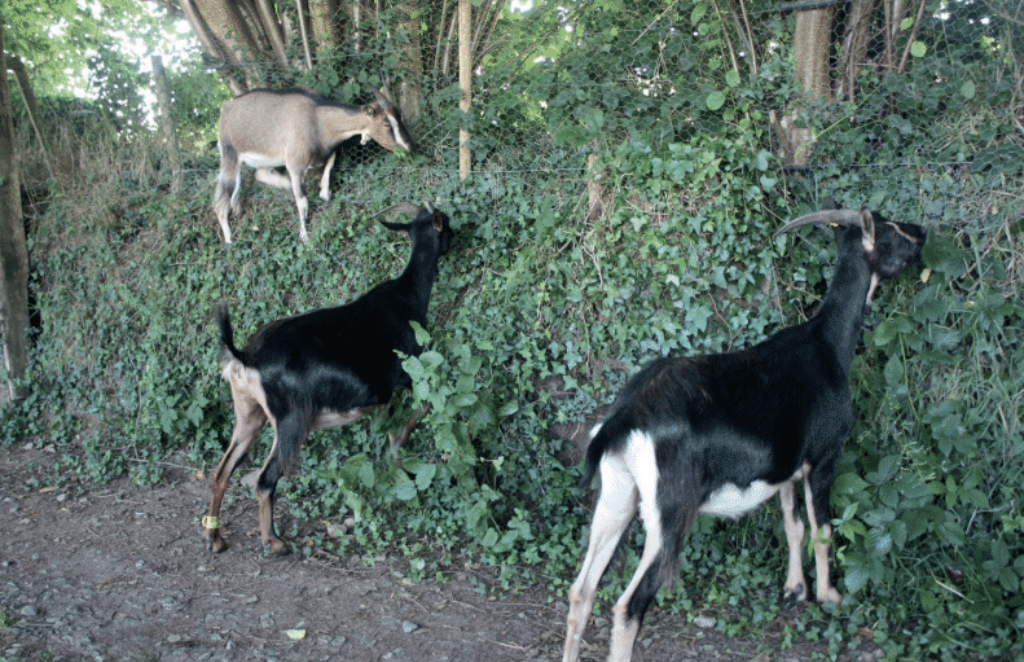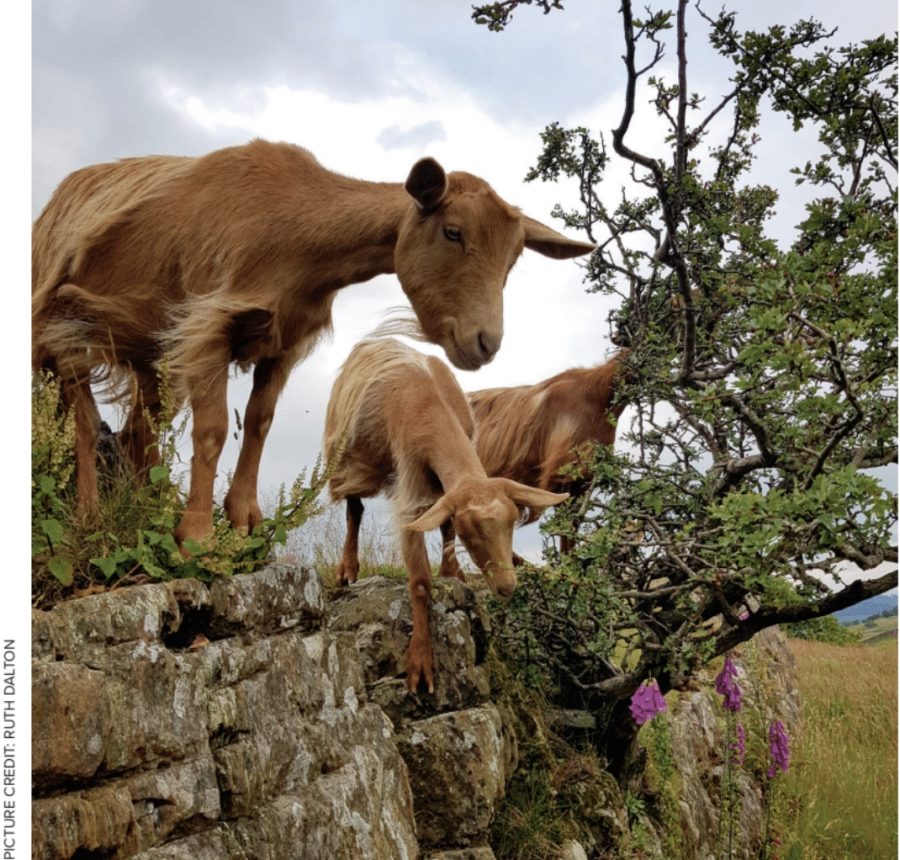Smallholder and goat keeper, Tamsin Cooper, explores if dairy goats can simultaneously encourage biodiversity while remaining productive.
Goats have a reputation for being destructive and difficult to contain, but can they simultaneously encourage biodiversity while remaining productive? Provided that the right animals are managed in an environmentally sensitive manner, regenerative farmers have already shown that they can.
HOW GOATS CAN HELP REGENERATION
For the soil to regenerate it needs a wide variety of plants, microbes, fungi, and insects. A balanced variety of native plants will encourage this healthy renewal and provide habitats and food for wildlife.When pastures are overstocked with grazing animals or when fields are sown with monocultures, this diversity is lost. However, a balance can be restored in time with the introduction of native plants and trees, while grassland can be kept open with carefully controlled light grazing. Goats perform best when part of a system of complementary grazers in a mixed species environment with plenty of varied vegetation. Goats are particularly skilled at removing undergrowth in hard-to-access locations where other grazers and machinery cannot reach. They much prefer trees, shrubs, weeds and tall grasses to meadow grass, and thrive on variety.
Whereas sheep and cattle will graze the sward, goats tend to browse around the paddock edges, snaffling brambles, gorse, nettles, thistles, and other spiky, thorny, or woody plants. Each plant becomes appetising to goats at a certain time of year. Goats are therefore useful for preventing the creep of brambles and other encroaching weeds into the field.
However, a goat herd kept in just one field will ravage all the weeds, undergrowth, and trees that they can reach within the first year of occupancy, and you will be left with long grass, bracken (which they barely eat and is poisonous in quantity), trees stripped of bark, and a tired pasture.
The secret is to keep the goats moving on a scheduled rotation to allow the plants to recover. Rotation also helps goats to avoid eating pasture with parasite larvae that would lead to gastrointestinal worms. This natural parasite control is much gentler on the environment, as pharmaceutical wormers also kill creatures that are beneficial to the soil.

PASTURE ROTATION
Depending on your land and means, there are different options for pasture rotation.The aim is to leave each paddock to recover for at least two months (the longer the better). Some herds remain in a large pasture for up to three weeks, while others are moved through smaller paddocks or strips every one to three days. During winter, goats can even manage woodland, clearing the undergrowth, provided that you move them on before new growth in spring.
Be careful to choose goats who do not strip bark. Most billies do, but nanny-goats vary widely in this behaviour. You will need strong stock fencing, at least at the pasture boundaries. For temporary internal division of pastures, four to five electric strands on fibre glass posts are ideal. These have the advantage of being easily and quickly set up and dismantled as the herd moves to fresh pasture. Insulated clips or reels can be used to attach the electric strands to a permanent stock fence. Alternatively, an electric net can be used. This is easy to set up and move, but tends to short out on longer vegetation. A solar panel and integrated battery charger make the whole kit more portable and eco-friendly.
People are often concerned that horned goats will get caught in electric fencing. With most goats, this is easily avoided through training. Goats learn quickly from observation. If your goats trust you, you can demonstrate to them that the fence hurts by pretending to receive a shock when you touch it. Put on your best ham acting skills and they’ll believe you.
Water and shelter must always be available, and a mobile shelter can suit a small herd. Combining or alternating with cattle, sheep or horses will make the most of your resources. Goats do not compete with these other species for food, so they do not add much to cattle or sheep stocking density. In fact, goats clear the scrub, granting your other animals access to grass. In addition, goats do not share the same worm species as cattle and horses, so the herbivores act in concert to clear the pastures of each other’s parasite larvae. However, be careful not to stock sheep highly, as goats are very susceptible to sheep worms.
CHOOSING THE RIGHT GOATS
Goats are highly individual beings with a range of skills and habits. For pasture management and for low-input farming (where costs are kept low for a moderate yield), goats need to be good foragers, hardy and adaptable.
However, modern high-yielding goats have lost some degree of survival skills through commercial breeding and management techniques. Firstly, goats bred for high yield do not have the body resources to also have high immunity and rugged physiques.
Goats with large udders are easily injured when exploring spiky thickets. On the other hand, old breeds were expected to provide for themselves, survive harsh weather, and raise their own kids. Goat keepers who use goats for pasture management tend to choose old breeds, such as Bagot, Golden Guernsey, English, Old English and Pygmy goats. These are hardier, more resistant to rainfall, and better adapted to the British climate.
Secondly, the environment a goat grew up in is preparation for their habits as an adult. Kids raised in barns where all food is supplied do not learn to forage and protect themselves, as they would free-ranging at their mother’s side. Kids learn a lot from their mother and other adult goats during their first few months. Dam-raised kids in a foraging herd will already have a much higher repertoire of plant knowledge than artificially-raised kids. They will know how to balance their diet, what to avoid, and how to access the nutritious parts of those woody, spiky weeds.
Finally, any animal that has multiple roles will reduce the carbon footprint of your activity. If your goat can provide food and environmental services, she will save you having to engage in further activities. If you eat meat, there is less waste if you consume your excess dairy stock, rather than breeding separate meat animals. Hardy dual-purpose breeds, although more moderate in output, tend to produce for longer. They are more eco-friendly all round.
In addition, if you can meet all your animals’ needs and compost any waste on site, this is highly beneficial to the environment: less waste, less industrial processing, less transport. As nettles and gorse can provide high protein levels for lactating animals, good foragers can find enough nutrition for their reproductive needs in nature.
DAIRY IN A HEALTHY ECOLOGY
Dairying practice has traditionally used specially bred dairy animals, at least since the early 1900s. We have long believed that these are the only goats to keep on the smallholding. However, those of us just wanting milk and cheese for the family have small requirements. I find that more than one Alpine produces too much to process without investing in freezer space.When you add the extra complications that dairy goats can suffer with healthcare, kidding complications, extra feed, footrot, and worms, it is actually a relief to have hardy animals that need very little care or vet bills. The more moderate yield of a Golden Guernsey, English or Old English goat is more manageable, and gives you the opportunity to put a couple of nannies in kid at the same time; it is so much healthier for the kids to have companions to grow up and play with.
Like dairy breeds, dual-purpose breeds have the. potential for a long lactation. In this case, yearly yield remains comparable without needing to kid every year, thus saving on time and expenses. Even with old breeds, be picky about your new herd. Some herds are not frequently handled, so are shy with people.This is often the case with Bagot goats. In fact, Bagot and Pygmy do not generally produce any more milk than is required for their kids.
Among the dual-purpose breeds, there are individual differences, depending on the foundation of the lines and the preferences of the breeder. While Golden Guernseys can provide three pints per day, there are many who produce less.There will always be a pay off between productivity and hardiness. If you want sturdier, tougher goats on your terrain, you will need to compromise on milkiness, so that your goats thrive and continue to produce when conditions are harsh.
English goats may be a suitable compromise between the ancient landracea nd a modern dairy goat. Old English have untapped potential of up to three pints per day at peak lactation, while remaining perfectly in harmony with their homeland’s ecology, both in physique and behaviour.
To receive regular copies of The Country Smallholder magazine featuring more articles like this, subscribe here.
For FREE updates from the world of smallholding, sign up for The Country Smallholder newsletter here.








